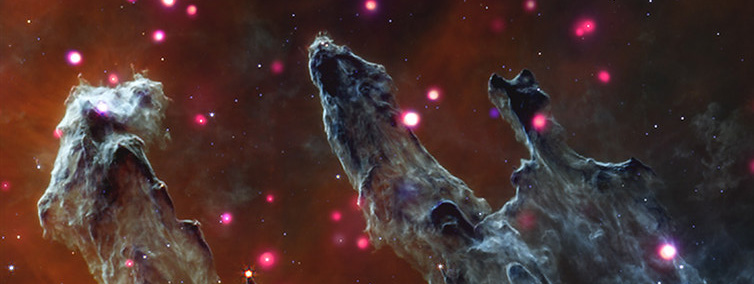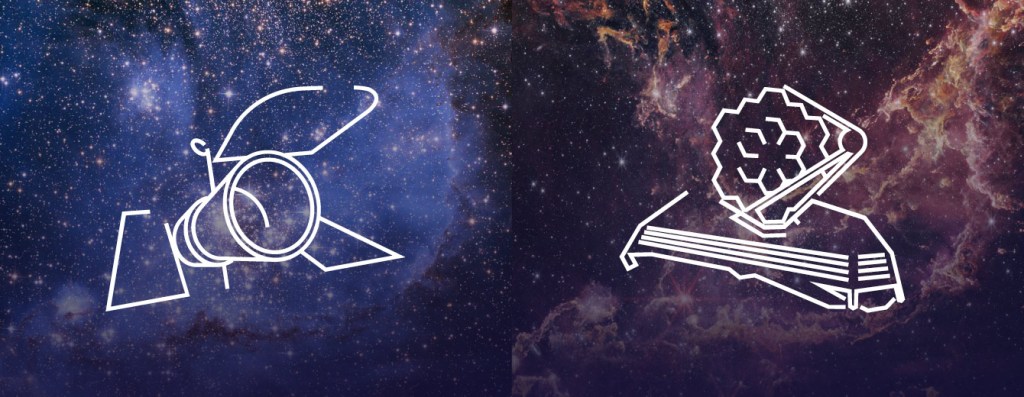About Webb Images
What you Need to Know
Details on the how, where and why of finding Webb images on the internet as well as information on the Webb specific diffraction spikes seen on stars in Webb images, how Webb images are made and more.
Where do I Find Webb Science Images?
Start with the Webb Image galleries on this site and the Webb Science Image News articles here. Then branch out to other sources listed below which are predominantly repeats though some sites offer additional views, resolutions or image products. The images on this site are official NASA released, peer reviewed science.
Latest Images : the most recent images in reverse chronological order.
More Webb Images: Images by year as well as Webb's very first images and more.
NASA Webb News : Webb science image feature articles appear in our news stream approximately weekly - go there to not only see the images but read the full story on each.
Webb Blog (offsite) : Webb science images/spectra occasionally appear here that are not yet peer reviewed and therefore not covered by NASA News feature articles. Often co-authored by scientists and engineers, blog posts have a less formal insiders point of view.
Webb FLICKR (Offsite) : 2024 | 2023 | 2022 | 1st Images | Engineering
Our WebbTelescope FLICKR channel contains the full set of Webb's latest NASA published images and spectra with brief descriptions and access to various downloadable resolutions.
STScI / WebbTelescope.Org Images: (Offsite) : In Depth- All Images/Products/Detailed Info – Space Telescope Science Institute is where raw Webb data is turned into Webb Science images. Access to all versions including the highest resolution print and uncompressed PNG versions of the latest NASA Published Webb images and spectra including multiple views from various Webb instruments and filters, detailed descriptions, meta-data, uncompressed high resolution image downloads, related products and more.
ESA's Webb Gallery (Offsite) : we often highlight ESA’s picture of the month. You can visit ESA’s Webb Gallery as an alternative source of Webb imagery and information. ESA has an extensive Webb gallery with access to various download resolutions, side by side draggable comparisons of various instruments and missions versions of some images and more.
Webb Social Media : X | Instagram | Facebook | Youtube

Why are some Webb images on the internet not available on NASA websites?
SHORT ANSWER: NASA/ESA/CSA/STScI generally only publish scientifically peer reviewed results. Exception: We occasionally post exceptional images/science on our Webb blog that are "pre-print" (still in peer review process).
DETAILS: Investigators from all over the world use Webb everyday to capture images and spectra.
Webb images, spectra, and resulting findings go through scientific peer-review BEFORE being released on NASA/STScI websites and social media.
However, Webb investigators sometimes post "preprint" versions of their papers on NON-NASA/STScI websites and social media before the full science peer-review process is complete.
In general, you will NOT find these "preprint" images/spectra/findings on NASA/STScI websites and social media therefore you must look for them (and related high-resolution images and meta-data) on the publishing institution's websites and social media.
Occasionally NASA and STScI in collaboration with the science community, may publish some exceptional "preprint" images/spectra/findings and they will be labelled as such.

Why do Webb Image Resolutions Vary?
Some images are mosaics of many images, others are subsets of a single image cropping a small section of the field of view during a particular instrument mode.
NASA/STScI Webb Images are always released at the highest resolution available based on the intrinsic resolution of the specific science image.
Image sizes and resolutions vary, sometimes dramatically, because some science images are mosaics assembled from many individual images whereas others maybe a specific astronomical object cropped from a single image possibly via the specific instrument mode employed.
Mosaic Example: Carina Nebula (offsite)
Total mosaic width 14575px by 8441px high - multiple NIRCam images assembled to create the image.
Crop/Masked Example: Exoplanet HIP65426b (offsite)
Four views of the exoplanet with different filters, each using coronagraph masks resulting in each exoplanet image ~350px wide arranged together into a ~1500px wide overall four panel image.
On this website, we will supply images/links to view the largest available image up to 4k pixel resolution. For resolutions greater than that, up to the full uncompressed versions of images, visit the STScI / WebbTelescope.Org (offsite) archive. But note, in some cases as noted above, there may not be a higher resolution image available.
Resolution Deep Dive: The maximum resolution of Webb's instrument detector arrays and instrument modes used for any particular observation determine maximum resolutions in non-mosaic images. For a deep dive into the details see :
Webb's NIRCam Field of View (offsite)
Webb's NIRCam Detectors (offsite)


Webb's Diffraction Spikes
Bright stars stand out in Webb images with their eight sharply defined diffraction spikes. In the linked infographic and transcript, the science behind Webb's diffraction spikes is explained (credit: STScI).
How are Webb Images Made?
Images don't come down from Webb in the beautiful full color renderings you see on this website and elsewhere. Someone has to translate the raw black and white image data into the color, especially since Webb collects light that falls outside of human vision. That’s where people like Joe DePasquale and Alyssa Pagan of the Space Telescope Science Institute come in. Learn how they makes choices about color and other aspects of space images.
Note: the following video embed is a playlist, to access all videos in the list, click on the 3 bar icon in upper right.
What is Webb Observing?
See current, upcoming and recent past observations scientists are making with the Webb Space Telescope. View details about each observation's science focus areas, the instruments used and more.
View the Tool
What is Webb Observing Next?
JWST science observations are nominally scheduled in weekly increments. Planned schedules will be posted as they are made available. Since the schedules do not take into account unforeseen events, including some target of opportunity observations, it is possible that the actual executed observations will differ from those planned.




























